Ice590: 3 x P-drop f.g. ice I + 10% by vol 1-micron Al2O3
Much more time and effort put into mechanical mixing of dust + ice than in run 515
| Conditions: all steps T = 220 K |
|
| P = 50 MPa, T = 220 K, s = 2 MPa |
step (1) |
|
| P = 50 MPa, T = 220 K, s = 4 MPa |
steps (2a, b, c....) |
|
| P = 50 MPa, T = 230 K, s = 3 MPa |
step (3) |
|
| P = 50 MPa, T = 230 K, s = 6 MPa |
step (4) |
|
| P = 50 MPa, T = 230 K, s relaxation |
step (5) |
|
| Legend: top graph of each pair is motor speed V (i.e., edot), bottom is load. Top graph is the one to pay attention to. Translate V to edot thus: V0.05 ≈ 3e-8/s (for 10:1 gearing V0.05 ≈ 3e-7/s). Horizontal scale is time. 5000 pts ≈ 14 hrs. |
|
|
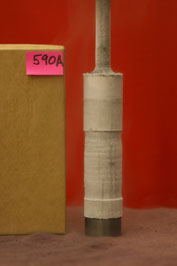 |
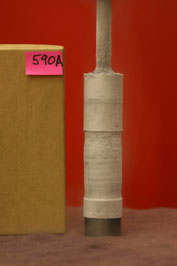 |
|
Sample at end of run. So: sample is perfect, signal stability throughout the run (force gage zero, in particular) was perfect. I also believe we'll find the distribution of particulates to be better than the one we did before (run 515): I examined the thin dried layer of al2o3 residue in the mortar this morning, the stuff left over after packing powder. It had very few lumps even at highest mag in a binocular microscope. So the odd behavior would seem to be real. Any LPSC abstract might hint that a little dust may have some big effects; we just don't quite know what they are yet. |
.png) |
|
Step (5), a few minutes of stress relaxation. This is only the bottom chart; piston stays fixed. Kirby used to do this with olivine 30 years ago; we'll ask him to reduce the data.
I observed much rebound at the end of this step, btw. But it needs closer examination; it may be an insidious collusion of machine effects. Too soon to mention in any LPSC abstracts. |
.png) |
e=0.203 |
1100 hrs 12/7, step (4), stress only 2x higher than step (3) but edot way faster than expected! Went through 7% strain, did not stop work hardening, and at the end was going at a rate that was still ~30x faster than at the end of step (3), meaning n = 5. Not your typical GSS creep. Also, with this extended work hardening, not like ice GSI creep either. |
.png)
|
e=0.131 |
0600 hrs 12/7, end step (3). Looks like it is slowly but steadily still slowing down. How odd. |
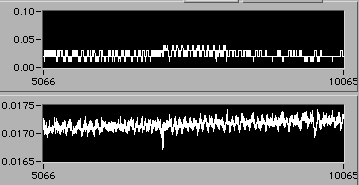 |
e=0.125 |
2100 12/6, step (3) continues. Doesn't look like too much evolution in strain rate. Will run another ~12 hrs, then double the stress level. Run will end mid day tomorrow. |
.png) |
|
~0800 12/6, first ~ 12 hrs of step (3). |
.png) |
|
Self loading at the end of step (2c), just as big as after (2b). Missed the first 120 s or so because of the obligatory stress gage zero measurement. The ~ 2.5 mV increase here ≈ 0.5 MPa, plus maybe the same amount over those first 120 s. How can this be possible?
Onward to 230 K. |
.png) |
e=0.103 |
1131 hrs 12/5, end step (2c). If there is any edot evolution here, in particular grain-growth related, it will require much more than 72 hrs to detect, so we're allowed to call it steady state. Next step is to raise to to 230 K, and carry on with same objective, to define n and Q, and look for signs of grain-size change. If n stays high and edot reaches steady-state, then clearly the particulates are suppressing GSS creep, regardless of what CSEM shows. This would be a fairly profound revelation. |
.png) |
e≈0.09 |
Step (2c) continues. Not work hardening. |
.png) |
e=0.08 |
1045 hrs 12/4, step (2c) continues. Is this steady state? I'd like to go another 12-24 hrs to check for evolution related to ...grain growth maybe...??? |
.png) |
e≈0.06 |
2139 hrs 12/3. Sample back in, step (2c) . This now work hardens, whereas (2b) did not. I'm mystified. Maybe it has to do with rebound, but there should also have been rebound previously. Stay tuned. |
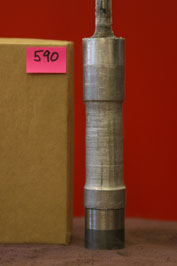 |
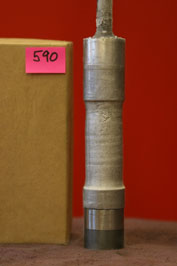 |
|
~1145 12/3 Sample removed to add a spacer so I can strain it farther. Holy s**t it looks nice! Two views 90 degrees rotated. Was careful not to let sample T rise above 220 K during this whole operation. Measured length, diameter, added 1/2" of spacer, then right back into the rig. |
.png) |
e≈0.05 |
~1100 12/3, same conditions, step (2b). Did an unload/reload for force gauge zeroing, and see how quickly edot found the steady state level of ~0.04. This more or less proves that the extended work hardening below is real and not a machine effect.
Big surprise when I then unloaded this sample (to take it out--see above): a huge self-loading rebound! Nicely documented. |
.png) |
e≈0.03 |
1740 hrs 12/2, step (2). Doubled the stress, now at e ≈ 0.03. May have finally reached steady state. n is evidently >3, and the work hardening is very non-GSS creep-like. Not shown: continued at edot ~0.04 steady overnight.
So far, we are reproducing run 515. Not what I expected at all. |
.png) |
e≈0.005 |
0830 hrs 12/2, step (1), after running all night, shows small but steady work hardening and a strain rate that is maybe 10x slower than what you'd expect of pure f.g. ice. Missing stuff before point 1333 also shows work hardening. 10:1 gearing, so this is still 10x faster than the slowest Mars stuff from the earlier study. |
`


.png)
.png)
.png)

.png)
.png)
.png)
.png)
.png)
.png)


.png)
.png)
.png)